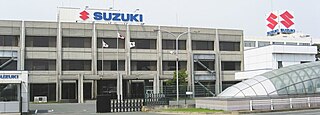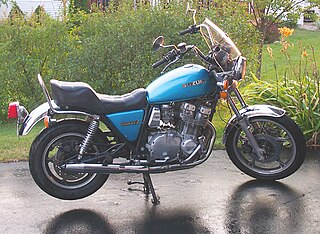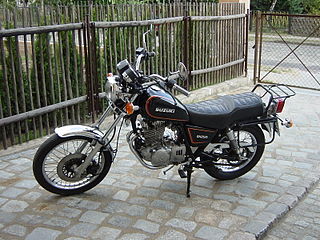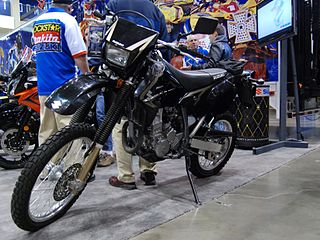
Motorenwerke Zschopau GmbH is a German motorcycle manufacturer located in Zschopau, Saxony. The acronym MZ since 1956 stands for Motorenwerke Zschopau GmbH. From 1992 to 1999 the company was called MuZ, an acronym for Motorrad und Zweiradwerk.

Yamaha Motor Co., Ltd. is a Japanese manufacturer of motorcycles, marine products such as boats and outboard motors, and other motorized products. The company was established in 1955 upon separation from Yamaha Corporation, and is headquartered in Iwata, Shizuoka, Japan. The company conducts development, production and marketing operations through 109 consolidated subsidiaries as of 2012.

Suzuki Motor Corporation is a Japanese multinational corporation headquartered in Minami-ku, Hamamatsu. Suzuki manufactures automobiles, four-wheel drive vehicles, motorcycles, all-terrain vehicles (ATVs), outboard marine engines, wheelchairs and a variety of other small internal combustion engines. In 2016, Suzuki was the eleventh biggest automaker by production worldwide. Suzuki has over 45,000 employees and has 35 production facilities in 23 countries, and 133 distributors in 192 countries. The worldwide sales volume of automobiles is the world's tenth largest, while domestic sales volume is the third largest in the country.
Semi-automatic transmission denotes a multi-speed motor vehicle transmission where part of its operation is automated, but the driver's input is still required to start from a standstill and to manually change gears. Most semi-automatic transmissions used in cars and motorcycles are based on conventional manual transmissions or a sequential manual transmission, but use an automatic clutch system. However, some semi-automatic transmissions have also been based on standard hydraulic automatic transmissions, with a fluid coupling or torque converter.

The Suzuki GS series was Suzuki Motor Corporation's first full range of 4-stroke powered road motorcycles, having previously almost exclusively manufactured 2-stroke machines. Suzuki had produced the 4-stroke Colleda COX 125cc and 93cc 4-stroke single-cylinder machines in 1955 however the rest of Suzuki's production from 1952 to 1976 had been increasingly sophisticated two-stroke road machines, whose ultimate expression was the 750cc 3-cylinder water-cooled GT750.
Cagiva is an Italian motorcycle manufacturer. It was founded in 1950 by Giovanni Castiglioni in Varese, originally producing small metal components. Giovanni's sons, Claudio and Gianfranco Castiglioni went into the motorcycle industry in 1978. The name is a portmanteau derived from the founder's name 'Giovanni Castiglioni' and the founding location, i.e. CAstiglioni GIovanni VArese.

The Burgman series of scooters is produced by Suzuki with engine capacities from 125 cc up to 638 cc.

The GN is a series of standard motorcycles built by Suzuki since the early '80s.

The Suzuki M engine family is a line of automobile engines from Suzuki. Ranging in displacement from 1.3 L to 1.8 L, it is a modern engine line with dual overhead cams, 16 valves, and multi-point fuel injection (MPFI).

The Suzuki DR-Z400 is a dual-sport motorcycle manufactured by Suzuki beginning in 2000. It is powered by a single-cylinder, 398 cc (24.3 cu in), carbureted, liquid-cooled four-stroke engine.

The Suzuki RF series are sport touring motorcycles. They came with three engine variations: 400 cc (24 cu in), 600 cc (37 cu in) and {900 cc (55 cu in). It was in production from 1994 to 1999.

The Suzuki TS series is a family of two-stroke, dual-sport motorcycles made by Suzuki since 1969. The series was the first Suzuki trail bikes sold on the mass market. Most of the TS line had an air-cooled engine and most models were introduced alongside the closely related TM (Motocross) or TC (trail) models, TF (farm) and also the DS which in most cases shared engine and chassis designs. Suzuki's first mass market motocross bike, the TM400 Cyclone, was introduced in 1971 and was based on the TS that first sold in 1969. A TS185ER model was available in a few countries.
The Suzuki DR-Z125 is a dirt bike manufactured by Suzuki as part of the Suzuki DR-Z series from 2003 to 2009. It was also sold as the Kawasaki KLX125 from 2003 to 2006. Most major parts are interchangeable between both early Kawasaki and Suzuki models as the Kawasaki is simply a rebranded DR-Z 125. Latter Suzuki models feature slightly different body panels which will not fit directly on earlier models. All models are intended for off-road trail use. Although the target audience for the motorcycle is the youth and small adult market, it is also available in "L" version which feature larger front and back wheels and sprockets, designed to accommodate larger adult riders. The "L" version is also equipped with hydraulic disc brakes in the front.

The Suzuki GSX125 is a small entry-level 125cc standard motorcycle designed specifically for emerging markets such as China, Southeast Asia, Africa and Latin America. Mostly, this motorcycle was built in the People Republic of China by Suzuki's joint venture, Haojue for local and export markets. This motorcycle also produced by Suzuki's subsidiary in Indonesia, PT Suzuki Indomobil Sales (SIS) from 2004 until 2015.
PT Suzuki Indomobil Motor is a joint venture between Suzuki Motor Corporation and the Indomobil Group. The company is located in Jakarta, Indonesia and specialized in manufacturing Suzuki vehicles for the local market. A separate company, PT Suzuki Indomobil Sales (SIS), previously PT Indomobil Niaga International, handled sales and marketing of Suzuki automobiles and motorcycles.
The "Pure Enduro" series of off-road racing motorcycles ran from 1977 through to 1984 in engine displacements from 175cc through 400cc. All engines were case-reed valve, air-cooled, two-stroke and single-cylinder with plain steel bores. Lubrication was provided via 20:1 pre-mix. These were directly related to the Suzuki RM series range of motocross racers.
Suzuki Motorcycle India, Private Limited (SMI) is the wholly owned Indian subsidiary of Suzuki, Japan. It was the third Suzuki automotive venture in India, after TVS Suzuki (1982–2001) and Maruti Suzuki (1982). In 1982, the joint-venture between Suzuki Motor Corporation and TVS Motor Company incorporated and started production of two wheelers in India. In 2001, after separating ways with TVS motor company, the company was re-entered as Suzuki Motorcycle India, Private Limited (SMI), in 2006. The company has set up a manufacturing facility at Gurgaon, Haryana with an annual capacity of 5,40,000 units.










